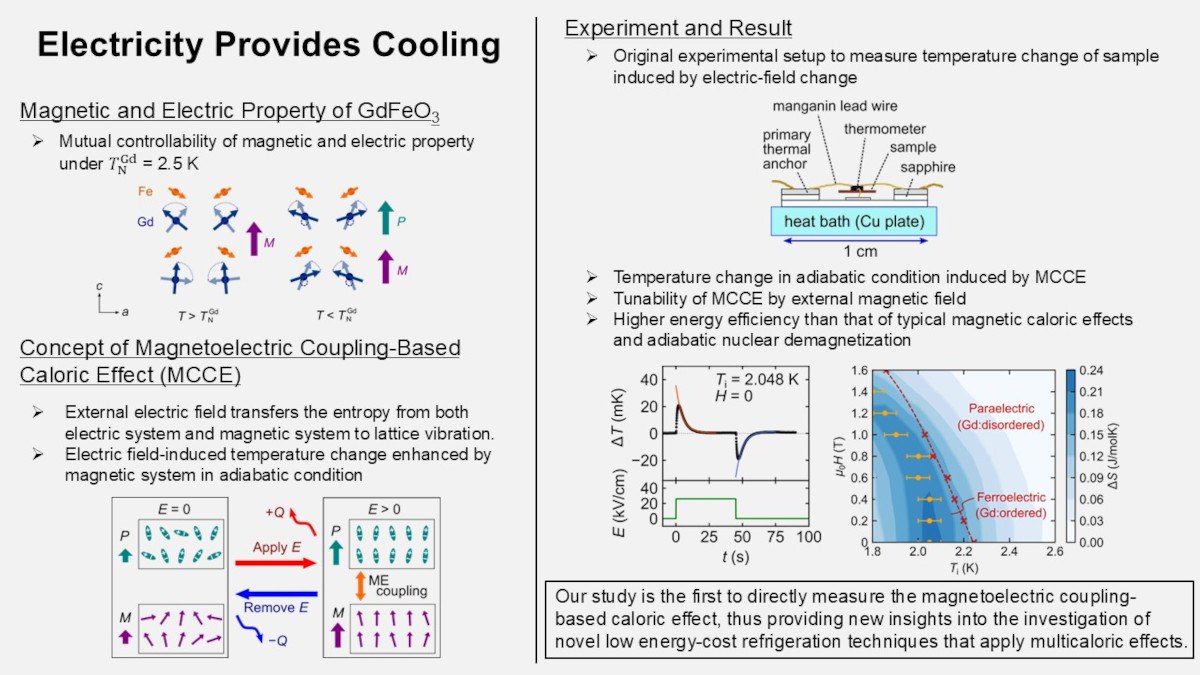Electricity Provides Cooling
© The Physical Society of Japan
This article is on
Magnetoelectric Coupling Based Caloric Effect in Multiferroic GdFeO3
(JPSJ Editors' Choice)
J. Phys. Soc. Jpn. 93, 094709 (2024).
Electric cooling at low temperatures is successfully achieved using a ferroelectric ferromagnetic solid instead of refrigerant gases such as fluorocarbons.

Increasing temperatures to higher than the surrounding temperature is easier compared with decreasing temperatures to lower than the surrounding temperature. Many refrigerators and air conditioners use latent heat when liquid evaporates. Additionally, the Joule-Thomson effect and thermoelectric effect, termed the Peltier effect, have been used for cooling. Aligning magnetic moments using an external magnetic field is another useful method for controlling entropy. This magnetocaloric effect is useful in magnetic refrigeration, which is the most important technology for achieving extremely low temperatures.
In principle, an electric field can be used directly for cooling as the magnetic refrigeration. However, to date, no practical electric refrigerators exist, because the reported electrocaloric effect is much weaker than the magnetocaloric effect.
The strong correlation between different degrees of freedom in condensed matter allows an external field, such as a magnetic field, an electric field, and stress, to modulate the states in multiple degrees of freedom. For example, magnetism and electricity are tightly coupled in ferromagnetic ferroelectric materials, also known as multiferroics. Magnetic moments and atomic displacements are simultaneously controlled by an electric field, thus resulting in significant entropy change.
In this study, the electrocaloric effect of GdFeO3 is investigated. The Fe moments are aligned to host weak ferromagnetism below 661 K. Addition, antiferromagnetic ordering of Gd moments emerges below 2.5 K. The coupling between Fe and Gd moments induces parasitic ferroelectric polarization. In other words, the Gd moments and ferroelectric polarization are strongly coupled. Therefore, if an external electric field is applied (removed) under adiabatic conditions, then the ordering of the Gd magnetic moments is expected to be enhanced (weakened). Hence, the Gd moment system loses (gains) some entropy, as shown in the lower-left panel. Entropy must be transferred to (from) lattice vibrations, thus resulting in an increase (decrease) in temperature.
This effect was successfully observed using the measurement system shown schematically in the top-right panel. A typical experimental result is shown in the lower middle panel. As shown, the temperature of GdFeO3 increased and decreased owing to the application and removal of an external electric field, respectively, as predicted. The magnitude of the temperature change was determined by the initial temperature and external magnetic field, as shown in the two-dimensional color plot (bottom right panel). Furthermore, the energy efficiency was higher than that of typical magnetic caloric effects and adiabatic nuclear demagnetization.
(Written by T. Arima on behalf of all the authors)
Magnetoelectric Coupling Based Caloric Effect in Multiferroic GdFeO3
(JPSJ Editors' Choice)
J. Phys. Soc. Jpn. 93, 094709 (2024).
Share this topic
Fields
Related Articles
-
Pressure-Tuned Classical–Quantum Crossover in Magnetic Field-Induced Quantum Phase Transitions of a Triangular-Lattice Antiferromagnet
Magnetic properties in condensed matter
Electron states in condensed matter
Cross-disciplinary physics and related areas of science and technology
2024-9-5
The correspondence principle states that as quantum numbers approach infinity, the nature of a system described by quantum mechanics should match that described by classical mechanics. Quantum phenomena, such as quantum superposition and quantum correlation, generally become unobservable when a system approaches this regime. Conversely, as quantum numbers decrease, classical descriptions give way to observable quantum effects. The external approach to classical–quantum crossover has attracted research interest. This study aims to demonstrate a method for achieving such control in materials.
-
Unification of Spin Helicity in the Magnetic Skyrmion Lattice of EuNiGe3
Magnetic properties in condensed matter
2024-8-7
In the magnetic skyrmion lattice of non-centrosymmetric EuNiGe3, the original magnetic helicity, determined by the antisymmetric exchange interaction, is reversed, resulting in a unified helicity.
-
Having a Good Friend around Makes Life Better
Cross-disciplinary physics and related areas of science and technology
2024-7-29
It is true that having a good friend around makes life better, and this idea is also true in the quantum world.
-
Antiferromagnetism Induces Dissipationless Transverse Conductivity
Electronic transport in condensed matter
Magnetic properties in condensed matter
Electronic structure and electrical properties of surfaces and nanostructures
2024-7-24
An investigation using high-quality NbMnP crystals demonstrates that the anomalous Hall conductivity arising from antiferromagnetism is dissipationless, as expected from the intrinsic mechanism.
-
Structural Rotation and Falsely Chiral Antiferromagnetism: A New Combination Generating Ferrotoroidic State
Magnetic properties in condensed matter
Dielectric, optical, and other properties in condensed matter
2024-7-4
The ferrotoroidic state, an exotic state of matter with broken space inversion and time-reversal symmetries, was achieved by combining structural rotation and falsely chiral antiferromagnetism in PbMn2Ni6Te3O18.
